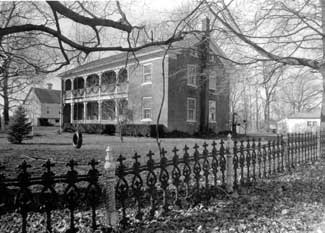Main Content
Article
County Survey Program
History of the Survey Program
The Indiana Historic Sites and Structures Inventory (IHSSI) of historic/architectural resources has been a continuing program of the Indiana Department of Natural Resources, Division of Historic Preservation and Archaeology (DHPA) since the mid-1970s. It is the responsibility of the DHPA’s Survey and Registration Section to administer and maintain the survey data that have been collected on all above-ground resources identified since the program began.

S. Mears House
Deer Creek Valley Rural Historical District
Delphi, IN
The major impetus for a comprehensive inventory of Indiana’s cultural resources came from the National Historic Preservation Act of 1966. The Act declared it the policy of the federal government to foster the preservation of our cultural resources in partnership with the states, local governments, and the private sector. In order to carry out this policy, the Act established the National Register of Historic Places, composed of buildings, sites, structures, objects and districts significant in American history, architecture, archaeology, engineering and culture. It also established a partnership between the federal government and the states, whereby each state developed a state historic preservation program to be approved by the U. S. Secretary of the Interior. To gain approval, the governor of the state appointed a State Historic Preservation Officer (SHPO) and a state review board. The DHPA serves as the State Historic Preservation Office for Indiana. Two of the responsibilities of the SHPO are directly related to the survey program. One is to conduct a comprehensive statewide survey of historic properties and maintain inventories of such properties for the purpose of locating, identifying, and evaluating cultural resources. Another responsibility is to protect such resources by ensuring that historic properties are considered in planning and development through the environmental review process.
In 1971, the Indiana State Legislature authorized creation of a state preservation program within the DNR and the DNR director was designated as the SHPO. The first full-time staff was hired in 1973 and the comprehensive survey program began in 1975. In 1978, an initial five-county survey project was completed by the Historic Landmarks Foundation of Indiana (now Indiana Landmarks) using federal grants-in-aid administered by the DHPA. Until 2008, the DHPA awarded federal grant money to local governments and non-profit organizations to undertake all city or county surveys of historic resources that occurred. On average, three counties were inventoried each year.
In 2008 the survey program underwent two major changes. The first was that the DHPA started overseeing the survey program. Instead of relying on outside entities to plan, undertake, review, and complete county surveys, the DHPA hired a staff person to manage this program. This change coincided with the move to electronic survey instead of paper survey. This programmatic shift was completed with financial assistance from the Indiana Department of Transportation and the Federal Highway Administration. Now instead of using paper survey cards, the surveyors use tablet computers that are equipped with electronic survey cards that they complete in the field, can be downloaded and reviewed electronically, and then converted directly into the DHPA’s online database. We are gathering the same information as paper surveys, but technology allows for easier and faster access, better ability to correct and update records, and expanded mapping capabilities.
What are Historic Resources?
What makes something historic? Age? Design? Not everything that is old is historic, so how does DHPA decide what is and what isn’t? It really boils down to making a judgment about what is important to our history and culture at a local, state, or national level. A resource that is important to your community but might never appear on a list of nationally significant places, can still be historic.
Some resources are important because they are wonderful examples of architecture or engineering. Others are important for their connection to past people or events. While age is a factor (most historic properties are more than 50 years old), it isn’t a hard and fast rule, and some newer resources (dubbed the “recent past”) already have proven their importance.
 It is easiest to understand “historic” in relation to buildings, but a bridge, a neighborhood, or a great piece of sculpture can also be historic. A historic resource might be a site where nothing above ground currently exists but where something important like a Native American village, a factory, or a battle once did exist or take place.
It is easiest to understand “historic” in relation to buildings, but a bridge, a neighborhood, or a great piece of sculpture can also be historic. A historic resource might be a site where nothing above ground currently exists but where something important like a Native American village, a factory, or a battle once did exist or take place.
In addition to having importance, historic resources also must have what preservationists call “integrity.” That is nothing more than the resource’s ability to tell its story. A locally important author’s home that looks much as it did when he or she wrote can still give us a glimpse into that writer’s world. By contrast, if Mount Vernon now were sheathed in stainless steel and tinted glass, it would still be important as George Washington’s home, but we would have great difficulty understanding how Washington lived from looking at Mount Vernon because the integrity would have been compromised.
What it basically comes down to is a historic resource has something important to tell us about ourselves and our past plus enough qualities to tell that story well.
The DHPA works to help identify above-ground historic resources through its Indiana Historic Sites and Structures Inventory (IHSSI)—a county-by-county survey of historic resources throughout the state. This program began in the mid-1970s and continues today.
Electronic Survey Process and Methodology
In Indiana above-ground surveys of historic resources are conducted on a county-by-county basis. County selection is based on the county’s location relative to gaps in survey information, known developmental pressures that might affect historic resources, and anticipated results based on staff knowledge of the state’s development. Other factors such as funding also enter into the selection process.
Survey and Registration staff completes initial planning for each county survey, including the evaluation of previously identified historic districts and identification of new historic districts. Preliminary research into a county’s history initially guides the field surveyors to understanding a county’s particular development. Once the historical research is complete, the county is systematically surveyed, township-by-township, by driving every public road. Every building, cemetery, and bridge or other above-ground resource that is at least 40 years old is surveyed. Surveyors complete a survey form, take photographs, and record a geographic reading via GPS for every property that meets these requirements and retains enough of its historic materials to be identified as historic construction. Each form records basic geographic information including county, township, city/town, address; architectural information including estimated date of construction, architectural type or style, building materials, changes/alterations for that building or structure; potential areas of significance and rating, and a site plan. The surveyor does not research the history of a property.
Once a surveyor completes records, they electronically submit them for review to the survey coordinator at DHPA. The coordinator reviews records for accuracy and either accepts records or returns them to the surveyor for revisions. Once all the records for a township are complete, they are added to the DHPA’s online database, SHAARD. If the township is a small, rural area, the entire survey process many only take a week. In larger, more populated cities, it can be months before the records are complete and in SHAARD.
The DHPA uses the survey in two major ways. The first is determining whether a property is eligible for the National Register of Historic Places. The survey form indicates which properties are likely to be eligible for the National Register and provides information that can be used in preparing nominations. When National Register applications are prepared by owners or other interested citizens, the DHPA uses the survey data to evaluate the property’s significance relative to others that have also been recorded in the inventory and to check the completeness of the information provided.
Under the requirement to protect historic resources, the DHPA uses survey data when reviewing state and federally funded projects to determine the impact of such projects on historic properties. The survey allows for more-thorough investigations of the historic resources within the proposed project areas.
Accessing Survey Information
All of our county survey information is entered into our SHAARD database. SHAARD also includes data from the Indiana Cemetery and Burial Registry, on historic bridges, properties listed in the National Register of Historic Places, historic theaters, and themed surveys like round and polygonal bards, buildings on stat college and university campuses, and statuary from the Save Outdoor Structures survey.
Non-DHPA Sponsored Surveys
Some local entities conduct their own architectural surveys for a neighborhood or city. Such surveys can be useful to local governments, professionals, citizens, and residents. They can aid in planning, development, allocation of funding, and increasing local support, appreciation and pride.
While the DHPA supports such efforts for local purposes, such surveys are not part of the SHPO-mandated survey program and, therefore, will not be consulted when evaluations and reviews are conducted for federal or state programs such as the National Register of Historic Places, Indiana Register of Historic Sites and Structures, environmental reviews, and eligibility for state or federal grants/tax credits.
Updating Survey Information
The DNR Division of Historic Preservation & Archaeology (DHPA) understands that over time buildings change. If a building that is included in the Historic Sites and Structures Inventory has been damaged or demolished, please contact the DHPA so we can update our database. Send an email to aborland@dnr.IN.gov with the 11-digit survey number and the current status of the building. Links or attachments to things like newspaper articles, photos, etc. to explain current situation are appreciated.
Additionally, sometimes buildings are overlooked at the time of survey. With the development of the SHAARD database, the DHPA has the ability to add a record if an oversight occurred. Qualified personnel may submit the necessary information (see below) and request a review for the creation of a new record in SHAARD. Be aware that the DHPA will only consider individual properties under this policy. The review of new historic districts must undergo a formal Determination of Eligibility.
The DHPA staff will edit, update or create a new record in SHAARD at our discretion based on the information that is provided. Additionally, as time passes and more buildings meet the 40-year threshold for survey, there is the likelihood that the DHPA will receive more requests for new records. Please be advised that the DHPA will only accept requests from counties that have been surveyed in the last five years.
To request that a new record be created in SHAARD:
- The request must come from qualified personnel with a professional involvement in the preservation field. This would include qualified professionals, local or state government agencies, and those in the history/architecture/preservation fields. Requests from members of the public will not be accepted.
- Only requests for individual properties from a county survey conducted within the last five years will be accepted. Requests to identify a new historic district will have to follow the procedure for obtaining a formal Determination of Eligibility.
- New information will be evaluated by the DHPA, and any associated new records will be created, once a month. New requests will not be reviewed upon receipt.
Information required should include all of the information gathered on survey records. This includes:
- Geographical information (county, township, city/town (if appropriate), address)
- Historical information (historic name, function, date of construction, style/type)
- Material information (current materials for foundation, walls, windows, roof, porches, and other elements)
- Condition (any changes/alterations to the property)
- Current exterior photographs
- Other information as available (history of building, etc.).
All information should be sent to Amy Borland.
